Blog & Latest Updates
Fly Fishing Articles
Insects by Common Name


> > The Yakima River
Landscape & scenery photos from the Yakima River

StateWashington
LocationYakima River
Date TakenJul 22, 2017
Date AddedJul 24, 2017
AuthorTroutnut
CameraCanon EOS 7D Mark II
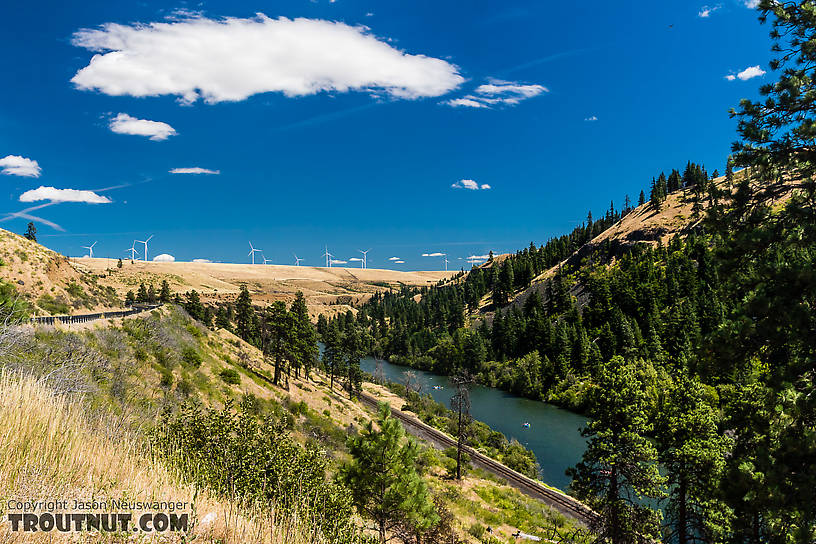
Yakima River from WA highway 10 near Teanaway, with rafters floating down.
StateWashington
LocationYakima River
Date TakenJul 22, 2017
Date AddedJul 24, 2017
AuthorTroutnut
CameraCanon EOS 7D Mark II
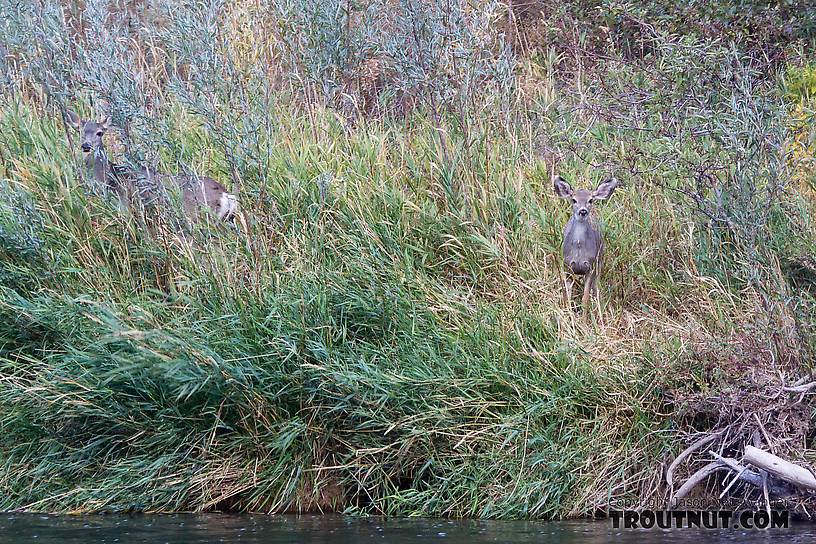
StateWashington
LocationYakima River
Date TakenOct 1, 2017
Date AddedOct 1, 2017
AuthorTroutnut
CameraNIKON 1 AW1
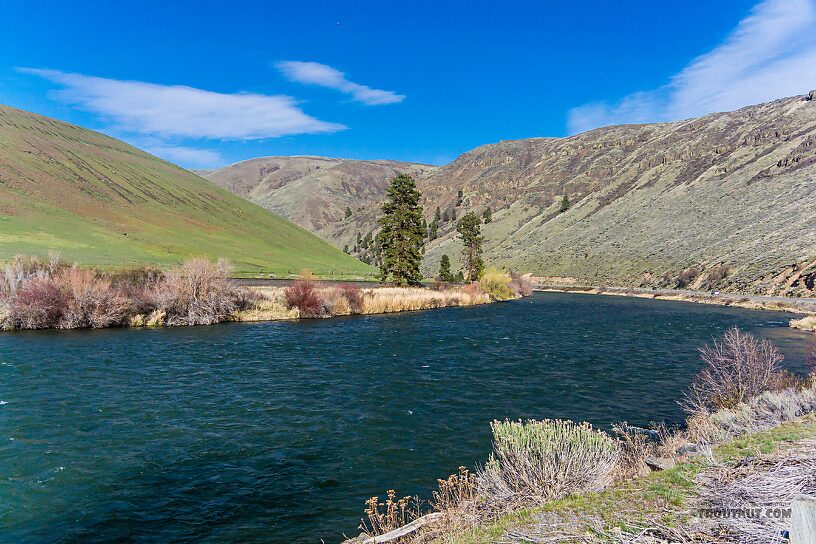
StateWashington
LocationYakima River
Date TakenApr 9, 2021
Date AddedApr 11, 2021
AuthorTroutnut
CameraNIKON 1 AW1

20" rainbow caught swinging a sculpzilla through a deep riffle
StateWashington
LocationYakima River
Date TakenOct 1, 2017
Date AddedOct 1, 2017
AuthorTroutnut
CameraNIKON 1 AW1
Closeup insects from the Yakima River
Brachycentrus americanus (American Grannom) Caddisfly Larva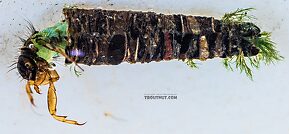 View 18 PicturesThis species of Brachycentrus was extremely common in mid-September kick net samples in the Yakima canyon.
View 18 PicturesThis species of Brachycentrus was extremely common in mid-September kick net samples in the Yakima canyon.
 View 18 PicturesThis species of Brachycentrus was extremely common in mid-September kick net samples in the Yakima canyon.
View 18 PicturesThis species of Brachycentrus was extremely common in mid-September kick net samples in the Yakima canyon.Collected September 12, 2020 from the Yakima River in Washington
Added to Troutnut.com by Troutnut on September 19, 2020
Added to Troutnut.com by Troutnut on September 19, 2020
Male Onocosmoecus unicolor (Great Late-Summer Sedge) Caddisfly Adult View 15 PicturesI first just assumed this was Dicosmoecus based on anglers' conventional wisdom since it's a large orange "October caddis," but Creno set me straight. I should have keyed it out. After another look under the microscope, it lacks an anepisternal wart on the mesopleuron (Mesopleuron: The side of the insect mesothorax, and the part to which the fore wings are attached in mayflies.), which rules out Dicosmoecus. The midtibiae have 2 apical (Apical: Close to the apex; tip or end.) spurs and 1 pre-apical (Apical: Close to the apex; tip or end.) spur, and from there the color pattern of the wing points to Onocosmoecus. The location then narrows the species to unicolor.
View 15 PicturesI first just assumed this was Dicosmoecus based on anglers' conventional wisdom since it's a large orange "October caddis," but Creno set me straight. I should have keyed it out. After another look under the microscope, it lacks an anepisternal wart on the mesopleuron (Mesopleuron: The side of the insect mesothorax, and the part to which the fore wings are attached in mayflies.), which rules out Dicosmoecus. The midtibiae have 2 apical (Apical: Close to the apex; tip or end.) spurs and 1 pre-apical (Apical: Close to the apex; tip or end.) spur, and from there the color pattern of the wing points to Onocosmoecus. The location then narrows the species to unicolor.
 View 15 PicturesI first just assumed this was Dicosmoecus based on anglers' conventional wisdom since it's a large orange "October caddis," but Creno set me straight. I should have keyed it out. After another look under the microscope, it lacks an anepisternal wart on the mesopleuron (Mesopleuron: The side of the insect mesothorax, and the part to which the fore wings are attached in mayflies.), which rules out Dicosmoecus. The midtibiae have 2 apical (Apical: Close to the apex; tip or end.) spurs and 1 pre-apical (Apical: Close to the apex; tip or end.) spur, and from there the color pattern of the wing points to Onocosmoecus. The location then narrows the species to unicolor.
View 15 PicturesI first just assumed this was Dicosmoecus based on anglers' conventional wisdom since it's a large orange "October caddis," but Creno set me straight. I should have keyed it out. After another look under the microscope, it lacks an anepisternal wart on the mesopleuron (Mesopleuron: The side of the insect mesothorax, and the part to which the fore wings are attached in mayflies.), which rules out Dicosmoecus. The midtibiae have 2 apical (Apical: Close to the apex; tip or end.) spurs and 1 pre-apical (Apical: Close to the apex; tip or end.) spur, and from there the color pattern of the wing points to Onocosmoecus. The location then narrows the species to unicolor.Collected September 17, 2020 from the Yakima River in Washington
Added to Troutnut.com by Troutnut on September 19, 2020
Added to Troutnut.com by Troutnut on September 19, 2020
Heptagenia pulla (Golden Dun) Mayfly Nymph View 11 PicturesThis specimen is interesting because Heptagenia pulla has not been reported from Washington or neighboring states (Saskatchewan is the closest), yet the distinctive key characteristics are clear.
View 11 PicturesThis specimen is interesting because Heptagenia pulla has not been reported from Washington or neighboring states (Saskatchewan is the closest), yet the distinctive key characteristics are clear.
It keys to the genus Heptagenia because the tarsal claw (Tarsal claw: The claws at the tip of the tarsus, on an insect's "foot.") has a single basal (Basal: close to the base; root or beginning) tooth, and the gills on segment 7 have fibrils.
For the species key:
1. The left mandible (Mandible: The paired jaws of an insect which are used for grabbing food, located immediately behind the labrum.) is planate (fairly straight-edged) whereas the right mandible (Mandible: The paired jaws of an insect which are used for grabbing food, located immediately behind the labrum.) is angulate (has one sharp turn on the edge).
2. The labrum (Labrum: The platelike structure forming the roof of the mouth of insects; the upper lip.) is much wider than long.
3. There's a thin light-colored streak lateral (Lateral: To the side.) to the eye on the head.
 View 11 PicturesThis specimen is interesting because Heptagenia pulla has not been reported from Washington or neighboring states (Saskatchewan is the closest), yet the distinctive key characteristics are clear.
View 11 PicturesThis specimen is interesting because Heptagenia pulla has not been reported from Washington or neighboring states (Saskatchewan is the closest), yet the distinctive key characteristics are clear.It keys to the genus Heptagenia because the tarsal claw (Tarsal claw: The claws at the tip of the tarsus, on an insect's "foot.") has a single basal (Basal: close to the base; root or beginning) tooth, and the gills on segment 7 have fibrils.
For the species key:
1. The left mandible (Mandible: The paired jaws of an insect which are used for grabbing food, located immediately behind the labrum.) is planate (fairly straight-edged) whereas the right mandible (Mandible: The paired jaws of an insect which are used for grabbing food, located immediately behind the labrum.) is angulate (has one sharp turn on the edge).
2. The labrum (Labrum: The platelike structure forming the roof of the mouth of insects; the upper lip.) is much wider than long.
3. There's a thin light-colored streak lateral (Lateral: To the side.) to the eye on the head.
Collected April 9, 2021 from the Yakima River in Washington
Added to Troutnut.com by Troutnut on April 12, 2021
Added to Troutnut.com by Troutnut on April 12, 2021
Isoperla fusca (Yellow Sally) Stonefly Nymph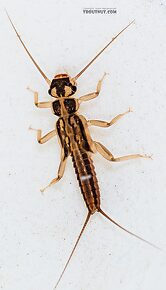 View 12 PicturesThis specimen keys to Isoperla fusca using the key in Szczytko & Stewart 1979, but some species of Isoperla weren't represented there.
View 12 PicturesThis specimen keys to Isoperla fusca using the key in Szczytko & Stewart 1979, but some species of Isoperla weren't represented there.
 View 12 PicturesThis specimen keys to Isoperla fusca using the key in Szczytko & Stewart 1979, but some species of Isoperla weren't represented there.
View 12 PicturesThis specimen keys to Isoperla fusca using the key in Szczytko & Stewart 1979, but some species of Isoperla weren't represented there.Collected April 9, 2021 from the Yakima River in Washington
Added to Troutnut.com by Troutnut on April 12, 2021
Added to Troutnut.com by Troutnut on April 12, 2021
Male Baetis tricaudatus (Blue-Winged Olive) Mayfly Nymph View 14 PicturesThis specimen and many like it were found with other specimens I found to be duller-colored females of the same species. I wasn't aware of such a difference between male and female nymphs in Baetids, but all the morphological characteristics I checked in the key were the same, and the color patterns are, too -- just not the brightness.
View 14 PicturesThis specimen and many like it were found with other specimens I found to be duller-colored females of the same species. I wasn't aware of such a difference between male and female nymphs in Baetids, but all the morphological characteristics I checked in the key were the same, and the color patterns are, too -- just not the brightness.
 View 14 PicturesThis specimen and many like it were found with other specimens I found to be duller-colored females of the same species. I wasn't aware of such a difference between male and female nymphs in Baetids, but all the morphological characteristics I checked in the key were the same, and the color patterns are, too -- just not the brightness.
View 14 PicturesThis specimen and many like it were found with other specimens I found to be duller-colored females of the same species. I wasn't aware of such a difference between male and female nymphs in Baetids, but all the morphological characteristics I checked in the key were the same, and the color patterns are, too -- just not the brightness.Collected April 9, 2021 from the Yakima River in Washington
Added to Troutnut.com by Troutnut on April 12, 2021
Added to Troutnut.com by Troutnut on April 12, 2021
Start a Discussion of the Yakima River:
Top 10 Fly Hatches
Top Gift Shop Designs
Eat mayflies.
Top Insect Specimens
Miscellaneous Sites
Troutnut.com is copyright © 2004-2024 Jason
Neuswanger (email Jason). See my FAQ for information about use of my images.
 privacy policy
privacy policy
